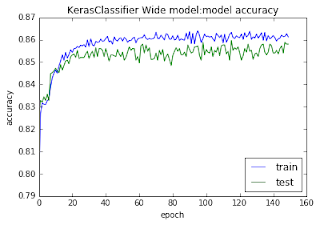Artificial Neural Network Project 1– Churn Modelling
Aim:
The main purpose of this post is to show how KerasClassifier(), i.e. an Artificial Neural Network can be used to predict a target variable. And how we can tune the parameters of a Neural Network to obtain a better model.
Dataset:
For this purpose, I have used the Churn Modelling dataset, in which the model has to predict whether the customer will leave the bank or not.
Initially, I will build 7 models with different network structures and select the best model for further tuning.
Common parameters for each model:
1. Epochs = 150
2. Batch_size = 10
3. Optimizer = adam
4. Activation function = relu
5. Network Weight Initialization = uniform
The dataset was divided into 75% training set and 25% validation set.
Models used:
Model 1: Sequencial Model: a sequential model is a linear stack of layers.
Network Structure: [6 --> 1]
Accuracy
|
Loss
|
|
Training
|
0.85
|
0.37
|
Validation
|
0.85
|
0.38
|
Accuracy
|
Loss
|
|
Training
|
0.86
|
0.35
|
Validation
|
0.85
|
0.35
|
Model 3:
KerasClassifier Small Model:
Accuracy
|
Loss
|
|
Training
|
0.83
|
0.40
|
Validation
|
0.84
|
0.41
|
Model 4:
KerasClassifier Wide Model:
Accuracy
|
Loss
|
|
Training
|
0.86
|
0.35
|
Validation
|
0.85
|
0.36
|
Model 5:
KerasClassifier Large Model: Network Structure: [6 --> 3 --> 1]
Accuracy
|
Loss
|
|
Training
|
0.79
|
0.51
|
Validation
|
0.80
|
0.50
|
Model 6:
KerasClassifier Deep Model: Network Structure: [6 --> 3 --> 2 --> 1]
Accuracy
|
Loss
|
|
Training
|
0.79
|
0.51
|
Loss
|
0.80
|
0.50
|
Model 7:
KerasClassifier Wide and Deep Model:
Network Structure: [12 --> 6 --> 3 --> 1]
Accuracy
|
Loss
|
|
Training
|
0.84
|
0.40
|
Validation
|
0.83
|
0.41
|
Best Models:
From the mean accuracy scores and model loss, 2 models
have performed better than others. They are Model 2 and Model 4, i.e. [Base KerasClassifier
and Wide Model].
Lets look at some prediction diagnostics of these two
models.
Looking at the recall’s, Model 4 performs better in predicting
the type 1 class, about 52% as compared to 38% in Model 2.
Also the overall precision, recall and f1-score are
better for Model 4.
Lets tune Model 4 to obtain a better model:
Parameters
|
Best parameter
|
Best Score
|
|
Epochs and
Batch_size
|
Epochs: [50,
100, 150]
Batch_size
: [10, 20, 40, 60, 80, 100]
|
Epochs = 50
Batch_size
= 60
|
85.93
|
Optimizer
|
['SGD','Adam','RMSprop','Adagrad',
'Adadelta', 'Adamax', 'Nadam']
|
Nadam
|
85.74
|
LearningRate
|
[0.001,
0.01, 0.1, 0.2, 0.3]
|
0.01
|
85.70
|
Network
Weight Initialization
|
['uniform',
'lecun_uniform', 'normal', 'zero', 'glorot_normal', 'glorot_uniform',
'he_normal', 'he_uniform']
|
Glorot_normal
|
85.96
|
Neuron
Activation Function
|
['softmax',
'softplus', 'softsign', 'relu', 'tanh', 'sigmoid', 'hard_sigmoid', 'linear']
|
Relu
|
85.84
|
Dropout and
weight_constant
|
weight_constraint = [1, 2, 3, 4, 5]
dropout_rate
= [0.0, 0.1, 0.2, 0.3, 0.4, 0.5, 0.6]
|
Dropout =
0.6
Wt_constant= 4
|
86.05
|
No. of
Neurons
|
[1, 5, 10,
15, 20, 25, 30, 40]
|
40
|
85.70
|
Final Model:
Although the overall precision, recall and f1-score of the tuned model remained same as the base model, if you look at the model accuracy and model loss graph of the final model, we notice that the model performs better in predicting the testing data, even better than training.
We are able to predict 45% of the people who are going to leave correctly and 97% of the people who will stay, an overall recall of 86%.
To view the full code for this project on Github, Click Here




















Comments
Post a Comment